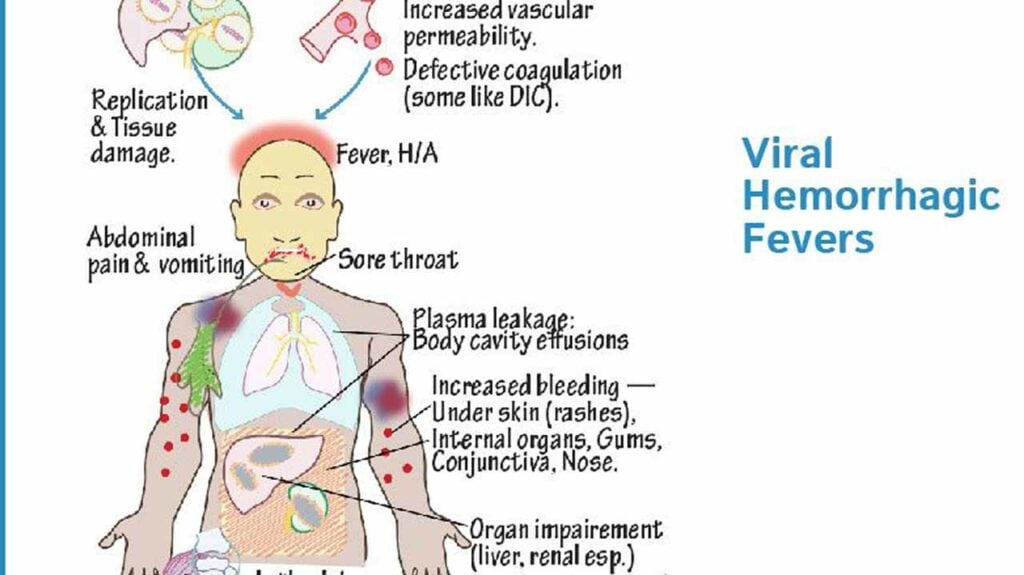Viral Hemorrhagic Fever (VHFs)
What are Hemorrhagic Fevers [VHFs]? Viral hemorrhagic fevers (VHFs) are a group of diseases that several distinct families of viruses cause. These different infectious diseases interfere with the blood’s ability to clot. VHFs can cause severe life-threatening illnesses. They can damage the walls of tiny blood vessels, making them leak. The resulting internal bleeding can range from relatively minor to life-threatening. Read More
Top Doctors For Viral Hemorrhagic Fever (VHFs) Treatments
Top Hospitals For Viral Hemorrhagic Fever (VHFs) Treatments
Viral Hemorrhagic Fever (VHFs)
Table of contents
- What are Hemorrhagic Fevers (VHFs)?
- Causes
- What are the risk factors of viral hemorrhagic fever?
- Symptoms
- Carriers/Hosts/Vectors of the VHF Viruses
- How is viral hemorrhagic fever diagnosed?
- How is viral hemorrhagic fever treated?
- What is the mortality rate of viral hemorrhagic fever?
- What are the complications of viral hemorrhagic fever?
- How can viral hemorrhagic fever be prevented?
- What are the viral families that can cause viral hemorrhagic fever?
- FAQ
What are Hemorrhagic Fevers (VHFs)?
Viral hemorrhagic fevers (VHFs) are a group of diseases that several distinct families of viruses cause. These different infectious diseases interfere with the blood’s ability to clot. VHFs can cause severe life-threatening illnesses. They can damage the walls of tiny blood vessels, making them leak. The resulting internal bleeding can range from relatively minor to life-threatening. Some viral hemorrhagic fevers include the following being stated below:
- Marburg.
- Ebola [EVD].
- Dengue.
- Crimean congo.
- Lassa fever.
- Yellow fever.
- Hantavirus pulmonary syndrome.
The spread of hemorrhagic fevers is by contact with animals, humans, or even insects. Regular fumigation of the environment can help in preventing infection. VHFs have common features or characteristics. They affect body organs, damage the blood vessels and affect the baby’s regular ability. The effects of some viral hemorrhagic fevers are mild, but some, including Ebola or Marburg, cause severe sickness and death. VHFs are found around the world. Specific diseases are usually limited to locations where their vectors [the animals or insects which carry them] live. Lassa fever is restricted to rural areas in West Africa, where the vectors [rats and mice] can be found habituating within. At present, no cure for viral hemorrhagic fevers has been found, despite their enormous threat to global health. Before the person travels from one country to another, get enough information about health-related facts concerning the place they are going. Personal care is vital and of great help to put from these hazards. Antiviral drugs [including ribavirin (Rebetol, Girasole, etc.)] may help delay the effects of some infections and so, prevent complications in some cases.

Causes
VHFs are caused by viruses. Hemorrhagic fever viruses occur naturally in some animals and insects, and they always infect people via contact with fluids or excretions from animals or other people infected with the viruses.
Common channels of transmission are:
- Touch.
Contact with infected persons, surfaces, or items.
- Water.
The viruses are also found in contaminated water or other fluids.
- Food.
In most contaminated foods, hazardous viruses can be found.
- Air.
A few varieties can be inhaled into the body system, for example: from infected rat feces or urine. The viruses can also be invited into the lungs when an individual finds himself in a concentrated area, such as markets, schools, hospitals, clubs, etc.
- Healthcare centers.
Health workers should be properly masked and gloved. Blood should be screened thoroughly, needles treated, bed covers changed for each patient, rooms of infected persons separated, and other good preventive measures in place.
- Unprotected sex.
What are the risk factors of viral hemorrhagic fever?
The factors that can increase the risk of contracting viral hemorrhagic fevers include all or some of the following as given below:
- Traveling [especially on international trips].
- Working or living with the sick.
- Sharing needles to use intravenous drugs.
- Slaughtering or eating infected animals.
- Having unprotected sexual intercourse.
- Exposure to infected blood or other infected body fluids.
- Working outdoors or in rat-infested buildings.
Symptoms

The initial signs and symptoms of VHFs may vary per disease.
Generally, the initial signs and symptoms may include the following:
- High fever.
- Weakness.
- Fatigue.
- Dizziness.
- Joints, bones, or muscle aches.
- Headache.
- Rashes.
In severe cases, some more symptoms of hemorrhagic fever are:
- Bleeding from the eyes, nose, ears, or mouth.
- Breathing difficulty.
- Internal bleeding.
- Failure of organs.
- Coma [a prolonged and deep state of unconsciousness].
- Shock [a condition where the organs do not receive enough blood or oxygen].
- Death.
Carriers/Hosts/Vectors of the VHF Viruses
- Animals:
- Rodents [rats, mice, rabbits, squirrels].
- Prairie dogs.
- Guinea pigs.
- Hamsters, etc.
- Insects:
- Ticks.
- Mosquitoes, etc.
- Infected people who are not the hosts but are infected by animals and insects [the hosts].
How is viral hemorrhagic fever diagnosed?
- In order to confirm the diagnosis of the patient, the doctor will examine the patient completely. The doctor will follow these steps in order to confirm the diagnosis.
- The detailed medical history of the patient
- The detailed travel history of the patient: In describing the international trip, details must include the countries the patient visited recently and the dates and history of any contact with possible sources of infection.
- Details of any exposure to rodents or mosquitoes.
- Blood sample tests: Hemorrhagic fevers are virulent and contagious; for this reason, the tests are usually performed in specially designated labs using strict precautions.
How is viral hemorrhagic fever treated?
- Medications
Antiviral drugs, such as ribavirin (Rebetol, Virazole), and others.
- Therapy
To prevent dehydration, fluids may be needed to help maintain the electrolyte balance-minerals (sodium and potassium) that are essential for nerve and muscle function.
- Surgical and other procedures.
The patient may need kidney dialysis during kidney failure.
What is the mortality rate of viral hemorrhagic fever?
Case-fatality rates of patients with VHF vary from less than 10% (e.g., in dengue HF) to as high as 90%. It has been reported in some filovirus outbreaks. The case-fatality rate for the 2014-2016 West Africa Ebola outbreaks was approximately 40%.
What are the complications of viral hemorrhagic fever?
Hemorrhagic fever can damage organs of the body leading to their dysfunction and, in most severe cases, causing death. Damaged areas may include:
- Brain – affects coordination
- Eyes – affects sight
- Heart – affects blood circulation and energy
- Lungs – affects breathing and oxygen supply
- Spleen – increased infection and reduction of the level of blood cells
- Kidneys – affects urination and urinary tracts
- Liver – excretion of chemical waste like bile from the blood will be hindered.
- Septic shock
- Multi-organ failure
- Death
How can viral hemorrhagic fever be prevented?
Wherever a person lives or works in or travels to areas where VHFs are common, the following precautionary steps to protect oneself are necessary. This may include using appropriate protective barriers such as:
- Hand gloves
- Eye goggles
- Face shield
- Gowns
- Use insect repellent, bed nets, window screens, proper clothing, and other insect barriers.
- Avoid contact with people who are sick after traveling to countries where the infection rate is high.
- Get vaccinated
- Guard against rodents
- Avoid mosquito and tick bites by controlling mosquitoes and ticks in the environment
For health workers, extra precautions include:
- Careful handling of lab specimens and waste
- Disinfection of lab specimens/waste
- Proper disposal of lab specimens and waste
What are the viral families that can cause viral hemorrhagic fever?
| Virus Family | Disease (Virus) | Natural Distribution | Usual Source of Human Infection | Incubation (Days) |
| Arenaviridae | ||||
| Arenavirus | Lassa fever | Africa | Rodent | 5-16 |
| Argentine HF (Junin) | South America | Rodent | 7-14 | |
| Bolivian HF (Machupo) | South America | Rodent | 9-15 | |
| Brazilian HF (Sabia) | South America | Rodent | 7-14 | |
| Venezuelan HF (Guanarito) | South America | Rodent | 7-14 | |
| Bunyaviridae | ||||
| Phlebovirus | Rift Valley fever | Africa | Mosquito | 2-5 |
| Nairovirus | Crimean-Congo HF | Europe, Asia, Africa | Tick | 3-12 |
| Hantavirus | Hemorrhagic fever with renal syndrome, Hantavirus pulmonary syndrome | Asia, Europe, worldwide | Rodent | 9-35 |
| Filoviridae | ||||
| Filovirus | Marburg and Ebola | Africa | Fruit bat | 2-216 |
| Flaviviridae | ||||
| Flavivirus | Yellow fever | Tropical Africa, South America | Mosquito | 3-6 |
| Dengue HF | Asia, Americas, Africa | Mosquito | Unknown for dengue HF, 5-7 for dengue |
FAQ
No vaccines are available to prevent these diseases. Two exceptions are yellow fever and Argentine hemorrhagic fever.
These symptoms are often accompanied by hemorrhage (bleeding). However, bleeding itself can rarely be a life-threatening condition. While some types of hemorrhagic fever viruses can cause mild illnesses, many of these viruses cause severe life-threatening diseases.
The route of transmission varies by a specific virus. Some viral hemorrhagic fever is spread by mosquito or tick bites. Others are transmitted by contact with infected blood or semen. A few varieties can be inhaled from infected rat feces or urine.
The report says that airborne transmission can also occur but is rare. Clinical manifestations of viral hemorrhagic fevers (VHFs) may include fever, myalgias, rash, and encephalitis, but presentations vary depending on the virus.
Medications. While no specific treatment exists for most viral hemorrhagic fever, the antiviral drug ribavirin (Rebetol, Virazole, others) may help shorten the course of some infections and prevent complications in some cases.
The outcome of viral hemorrhagic fever depends on the type of disease the patient suffers from.






























































































